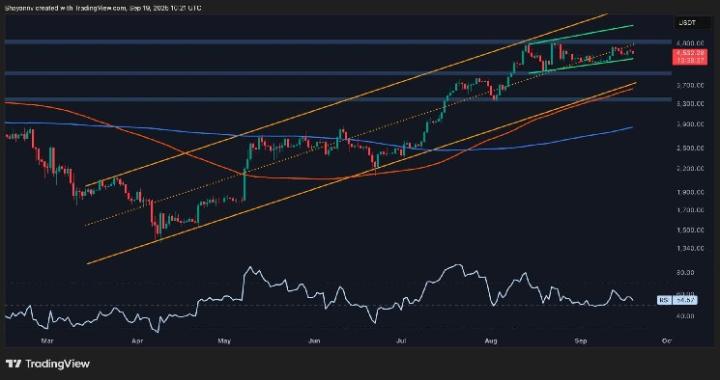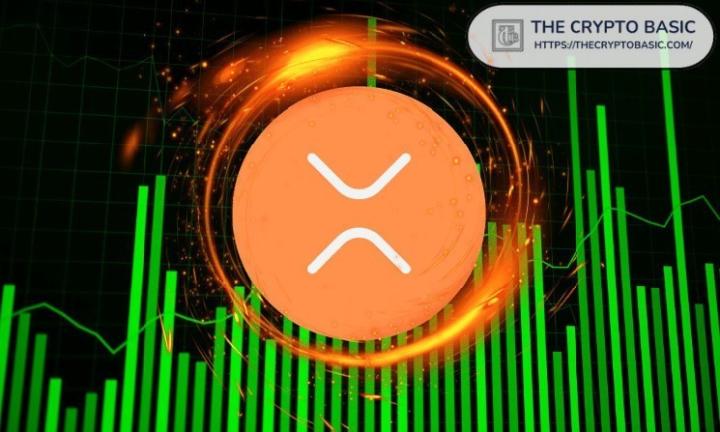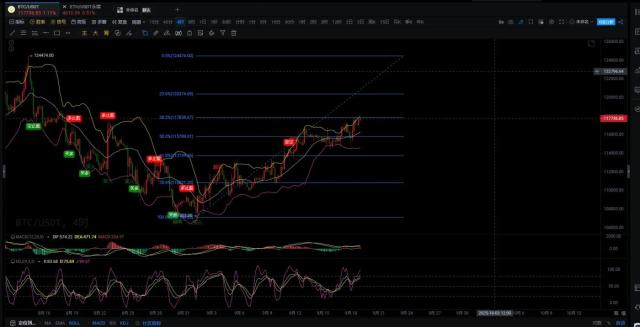Humans don’t need banks, and payments don’t need humans
In 2008, under the shadow of the financial crisis, Bitcoin gained its first batch of ordinary users who were disappointed with the fiat currency system and stepped out of the niche community of crypto-punks.
At the same time, the term FinTech (financial technology) has gradually become popular since 2008, almost at the same time as Bitcoin, which may be a coincidence.
It could be even more coincidental. In 2013, Bitcoin's first bull market arrived, and the price exceeded $1,000. FinTech also began to become mainstream. Wirecard and P2P, which were once popular, fell into decline. Yu'ebao defined the income system in the Internet era, and Twitter founder Jack's new payment solution Square was valued at over $6 billion.
This is not artificially created. Since 1971, the growth rates of gold prices and the size of U.S. debt have been almost synchronized, 8.8% vs 8.7%. After the gold dollar came the petrodollar. Will the new energy dollar be a stable currency?
In the eyes of regulators, Fintech is the salvation of the banking industry. It uses Internet thinking to redefine or supplement the financial system, hoping to recreate an Internet-based financial system within the complex relationship between government and business.
Starting from the payment field, it has become a consensus around the world that acquiring, aggregation, P2P, cross-border settlement, and micro-loan business, cross-border and mixed operations, have created endless prosperity or crisis.
Unfortunately, what really changes banks and the traditional financial system behind them is blockchain practice, which has gone from the margins to the mainstream, and everything is happening outside of regulation.
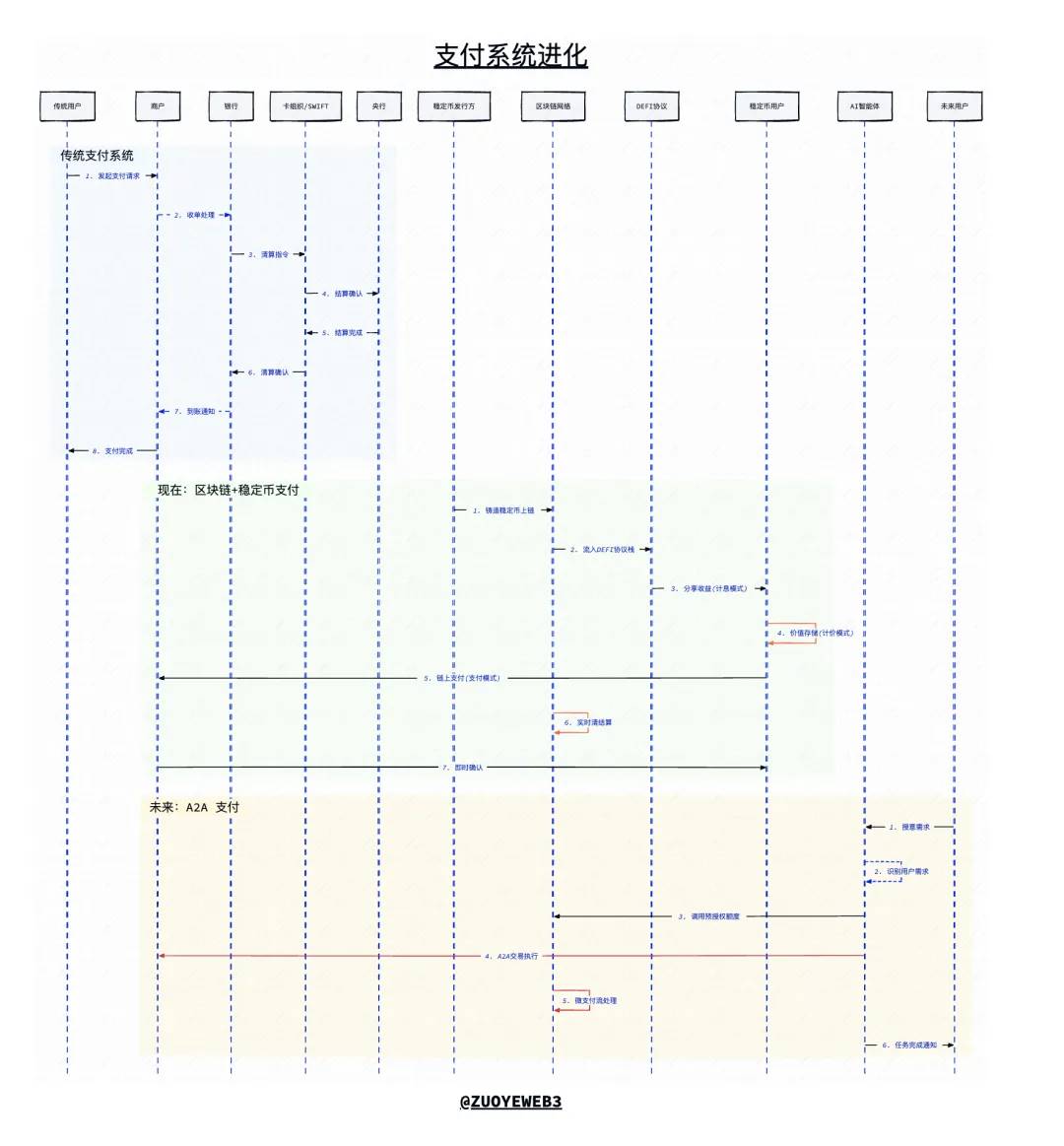
Image Caption: Evolution of Payment Systems
Image source: @zuoyeweb3
Payments are rooted in code, not finance
Yield-generating stablecoins use USDT dividends as a sign of maturity.
For the past few hundred years, payments have been centered around the banking industry. All electronic, digital, or internet-based processes have contributed to the banking industry until the emergence of blockchain.
Blockchain, especially stablecoins, has created an inverted world, completely reversing the order of payment, clearing and settlement. The payment process can only be completed after confirmation that clearing and settlement are possible.
In the traditional banking system, payment issues are essentially a binary process of front-end transfer and back-end settlement, with the banking industry at the absolute center.
In the Fintech mindset, the payment process is an aggregation and B-side service industry. The Internet's customer acquisition mindset requires that no payment collection traffic be missed. Traffic determines the confidence of Fintech companies in facing banks. Fake it till make it, and China UnionPay and deposit are the final results of being accepted.
Under the blockchain thinking, stablecoin systems such as USDT, Tron as the earliest stablecoin L1, and Ethereum as a large-value clearing and settlement system have realized the "programmability" that should have been achieved by the Internet.
The lack of interconnection is an external manifestation of the platform's scramble for territory. The core reason is that the US dollar is not sufficiently internet-connected. Going online will always be just a supplement to the fiat currency system. However, stablecoins are a native asset form for blockchains. USDT on any public chain can be exchanged with each other, and the friction cost depends only on liquidity.
Therefore, based on the characteristics of blockchain, pre-payment confirmation can only be completed after verification that clearing and settlement can be carried out. The Gas Fee is determined by the market mechanism and can be circulated in real time after confirmation.
An counterintuitive thought is that it is not unregulated arbitrage that gave birth to the stablecoin system of blockchain, but the efficiency brought by programmability that defeated the traditional financial system.
Important
Payments is an open system rooted in code, not finance.
We can give a counterexample. The reason why traditional bank wire transfers are time-consuming and the compliance requirements and outdated network architecture are just superficial phenomena. The core reason is that the participating banks have a "retention" demand. Massive amounts of funds will generate uninterrupted income, and users' time has become the passive compound interest of the banking industry .
From this perspective, after the Genius Act, the banking industry is still frantically preventing the income system from entering the banking system. The superficial reason is still income, or paying interest to users will distort the banking industry's deposit and lending mechanism, and ultimately cause a systemic crisis in the financial industry.
The on-chain programmability of the revenue system will eventually replace the banking industry itself rather than creating more problems than the banking industry because it will be an open system.
Traditional banking earns its profits from the interest rate spread between user deposits and corporate/individual user loans, which is the basis of all banking operations.
The interest rate spread mechanism gives the banking industry two-way power to select users . It can create unbanked people on the left and select companies that do not meet the "standards" on the right.
Ultimately, ordinary users will have to bear the losses caused by banks due to triangular debts or financial crises . In a sense, the same is true for USDT. Users bear the risks of USDT, and Tether takes the issuance income of USDT.
YBS (yield stablecoins) such as Ethena neither rely on the US dollar for issuance nor operate under the traditional banking interest rate spread mechanism. Instead, they are entirely based on on-chain facilities such as Aave and public chains such as TON for payment attempts.
Now the income-generating stablecoin system has created a global liquid payment, interest calculation and pricing system. The banking industry has become the target of stablecoin transformation, not by transforming the way of participating in the payment process, but by changing the intermediary position of the banking industry in credit creation.
Faced with the onslaught of yield-based stablecoins, small banks are the first to bear the brunt. Minnesota Credit Union has already tried to issue its own stablecoin, and former Neo Banks are also rapidly moving on-chain. For example, Nubank has begun to re-experiment with stablecoins.
Even SuperForm and others have begun to transform themselves into stablecoin banking systems, where users share in the profits generated by the banks, thus straightening out the distorted banking system.
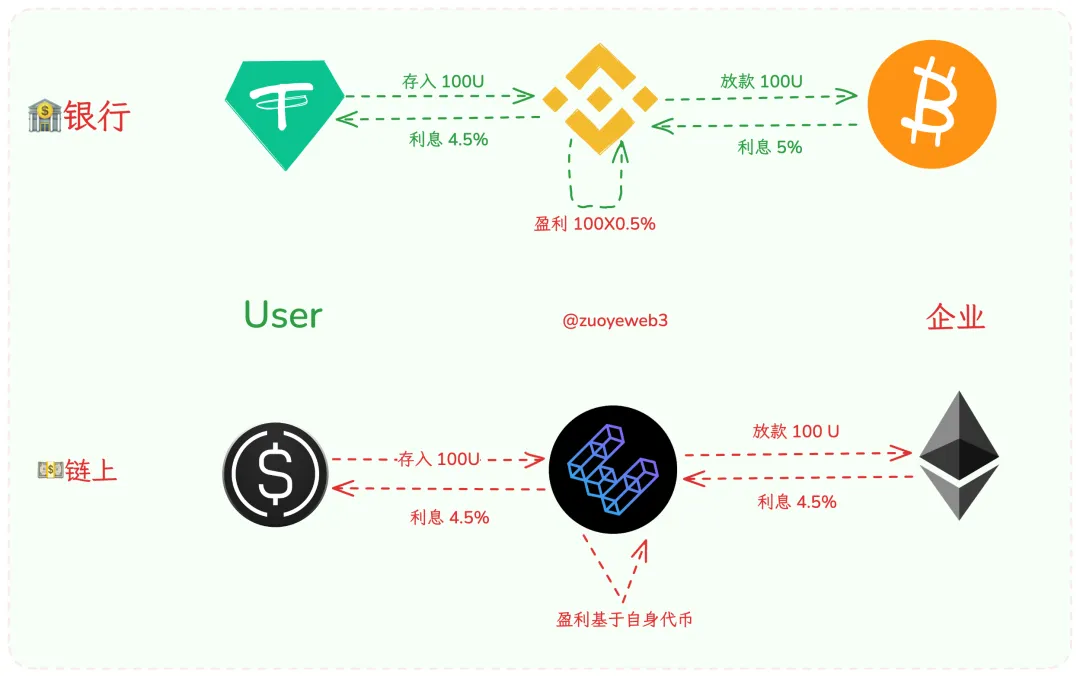
Image caption: YBS's impact on the banking industry
Image source: @zuoyeweb3
In a nutshell, the yield-based stablecoin (YBS) is not a way to acquire customers, but a harbinger of reshaping the banking industry. The on-chain migration of credit creation is a more profound transformation than stablecoin payments.
Fintech does not replace the role of banks, but rather makes improvements in areas that banks are unwilling or unable to get involved in. However, blockchain and stablecoins will replace the definition of banks and currency.
We assume that YBS will become the new US dollar circulation system, and payment itself is synonymous with on-chain payment. Note again that this is not a simple on-chainization of the US dollar. Unlike the Internetization of the US dollar, the on-chain US dollar is the legal currency system.
At this stage, the traditional payment system's view of stablecoins is limited to the two areas of clearing and settlement and cross-border transactions. This is a completely wrong established mindset. Please give stablecoins freedom and do not embed stablecoins into outdated payment systems.
The blockchain naturally does not distinguish between domestic and foreign, cards/accounts, individuals/enterprises, or payments/receivers. Everything is just a natural extension and variation of transactions. As for the corporate accounts or private transfers of the stablecoin L1, it is nothing more than the adaptation of programming details and still follows the basic principles of blockchain transactions such as atomicity, irreversibility, and non-tamperability.
The existing payment system is still closed or semi-closed. For example, SWIFT excludes customers from specific regions, and Visa/MasterCard requires specific software and hardware qualifications. An analogy can be made: the banking industry rejects those who do not have high profits as unbanked, Square Paypal will reject specific customer groups, and blockchain welcomes everyone.
Closed systems and semi-open systems will eventually give way to open systems. Either Ethereum will become the stablecoin L1, or the stablecoin L1 will become the new Ethereum.
This is not regulatory arbitrage by the blockchain, but a dimensionality reduction attack brought about by efficiency upgrades. Any closed system cannot form a closed loop, and transaction fees will be reduced at each link to compete for users. Either the monopoly advantage is used to increase profits, or regulatory compliance is used to exclude competition.
In an open system, users have absolute autonomy. Aave did not become the industry standard because of its monopoly, but because Fluid and Euler's DEX and lending models have not yet fully emerged.
But in any case, on-chain banks will not be tokenized deposits in the banking industry, but tokenized protocols will rewrite the definition of banks.
Warning
Replacing banks and payment systems will not happen overnight. Paypal, Stripe, and USDT were produced 20, 15, and 10 years ago, respectively.
The current issuance of stablecoins is around $260 billion, and we will see $1 trillion in issuance within the next five years.
Web2 payments are a non-renewable resource
Credit card fraud processing relies heavily on experience and manual operations.
Web2 payments will become the fuel for Web3 payments, ultimately completely replacing rather than supplementing or coexisting.
Stripe is the only correct choice to participate in the future based on Tempo. Any attempt to incorporate stablecoin technology into the existing payment stack will be killed by the flywheel - it is still an efficiency issue. The on-chain YBS has a dichotomy between income rights and usage rights, while the off-chain stablecoin only has usage rights . Capital will naturally flow to the value-added track.
While depriving the banking industry of its social identity, stablecoins are also clearing up the established thinking of Web2 payments.
As mentioned earlier, the issuance of stablecoins is gradually moving away from the simple imitation of USDT. Although completely breaking away from the US dollar and the banking system is out of reach, it is no longer a complete fantasy. From SVB to Lead Bank, there will always be banks willing to do crypto business. This is a long-term journey.
In 2025, it is not just the banking industry that is embracing stablecoins. Several major obstacles that previously plagued blockchain payment businesses are gradually being resolved, and the influence of Bitcoin has become the voice of stablecoins.
• Deposits and withdrawals: People no longer pursue fiat currency finality. They are willing or inclined to hold USDC/USDT to earn returns, use directly, or hedge against inflation. For example, MoneyGram and Crossmint have partnered to process USDC remittances.
• Clearing and Settlement: Visa completed $1 billion in stablecoin clearing volume. Rain is its pilot unit, and Samsung is a Rain investor. The anxiety of the old giants will become the source of funds for stablecoin payments.
• Big banks: RWA or tokenized deposits are just appetizers. It is not far away to consider competing with DeFi. Evolution is the passive adaptation of traditional finance. Internet alliances such as Google AP2 and GCUL are the unwillingness and struggle of the hegemons of the old era.
• Issuance: From Paxos to M0, the traditional compliance model and the on-chain package model go hand in hand, but the revenue system will be taken into consideration. Although Paxos’ USDH solution failed, empowering users and tokens is a common choice.
In summary, the competition for stablecoin on-chain payments has ended, and the combination competition has begun, that is, how to promote the network scale effect of stablecoins to the world.
In a sense, USDT has already pushed stablecoins to Asia, Africa, and Latin America. There is no longer any new room for growth in the region, and it can only be a "scenario." If the existing scenario is "blockchain-enabled" by payment players,
Then we can only seek new "blockchain+"/"stablecoin+" scenarios. This is the clever use of Web3 in the Internet strategy, buying volume for growth and cultivating new behaviors . The future will define today's history, and Agentic Payment will definitely be realized.
After changing the banking and payment systems, let’s talk in depth about the future of the agent-oriented payment system. Please note that the following does not consider the “ + blockchain ” or “ + stable currency ” scenarios at all. It is a complete waste of words. There will be no market space for existing payment giants in the future.
The revenue system can incentivize end-user usage, but new payment behaviors require supporting consumption scenarios. For example, it is reasonable to use cryptocurrency to consume in the Binance built-in mini program, but it is very strange to use a bank card in the WeChat mini program.
This new scenario can only be A2A (Agent 2 Agent) in the eyes of Google, Coinbase and even Ethereum. It does not require deep human involvement at all. Web2 payment is a non-renewable resource because payment will be everywhere in the future.
Simply put, in the future, people will have multiple agents handling different tasks, and MCP (Model Context Protocol) will configure resources or call APIs within the agent, ultimately presenting us with agents matching each other and creating economic value.
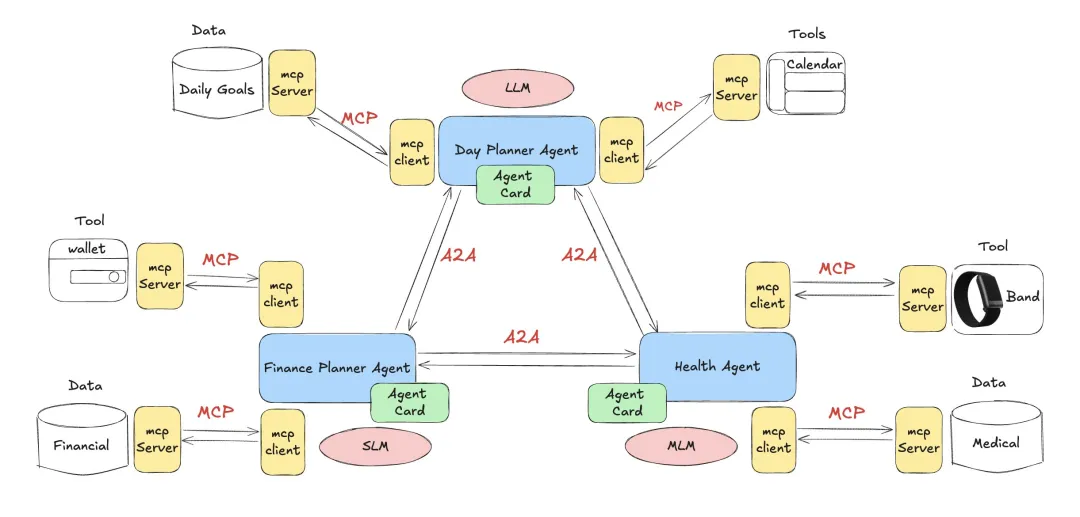
Image caption: A2A and MCP contact
Image credit: @DevSwayam
Human behavior will be more about instruction rather than authorization. You must give up your multi-dimensional data in order for the AI Agent to meet your inner needs.
Note
• The value of people lies in empowerment
• Tireless machine operation
Existing pre-authorization and prepayment, buy now, pay later, acquiring/issuing, and clearing/settlement will occur on the chain, but the operator is the Agent. For example, traditional credit card fraud requires manual processing, but the Agent will be smart enough to identify malicious behavior.
Considering the existing payment stack and the “central bank-bank” system, one would indeed think that the above idea is beyond one’s capabilities. However, don’t forget that the “ payment and transfer ” of the digital RMB is also a compromise made to the banking system from a profit perspective.
It’s not that I don’t want to do it, but I really can’t.
Google has adopted the AP2 protocol built by Coinbase, EigenCloud, and Sui, and has highly integrated it with Coinbase's x402 gateway protocol. Blockchain + stablecoin + Internet is currently the optimal solution, targeting small-amount flow payments (Microtransactions). In its vision, real-time cloud usage, article paywalls, etc. are all real scenarios.
Well, we can be sure that the future belongs to AI Agents, which will transcend clearing and settlement channels, but the specific path by which they will change humanity is still unknown.
The DeFi field still lacks a credit market, which is naturally suitable for corporate development. However, for a long time, retail investors or individual markets have relied on the over-collateralization mechanism to become the main force, which is itself an abnormal phenomenon.
There is no way to imagine the implementation path of technological development, we can only outline its basic definition, such as Fintech, DeFi, and Agentic Payment.
Caution
The irreversible nature of stablecoin payments will also give rise to new arbitrage models, but we are unable to imagine their harmfulness.
In addition, the existing distribution channels will not be the core battlefield for the large-scale use of stablecoins. There will be usage, but the profit potential of its interaction with the on-chain DeFi stack will be damaged. This is still a fantasy that the emperor will use a golden hoe to dig vegetables.
Only when stablecoin payments replace banks and existing distribution channels can it be called a Web3 payment system.
Conclusion
The implementation path of the future non-bank payment system that I imagine: revenue + clearing and settlement + retail investors (network effect) + agent flow payment (after getting rid of the self-rescue of the old giants) .
The current impact is still concentrated on Fintech and the banking industry, and there is little ability to replace the central bank system. This is not because it is technically infeasible, but because the Federal Reserve still plays the important role of the lender of last resort (the scapegoat).
In the long run, distribution channels are an intermediate process. If stablecoins can replace bank deposits and there is no channel to lock liquidity, but on-chain DeFi has no access and no user restrictions, will it trigger a more violent financial crisis?
The Soviet Union could not eliminate the black market, and the United States cannot ban Bitcoin. Whether it is a raging flood or the other side of happiness, there is no turning back for mankind.




